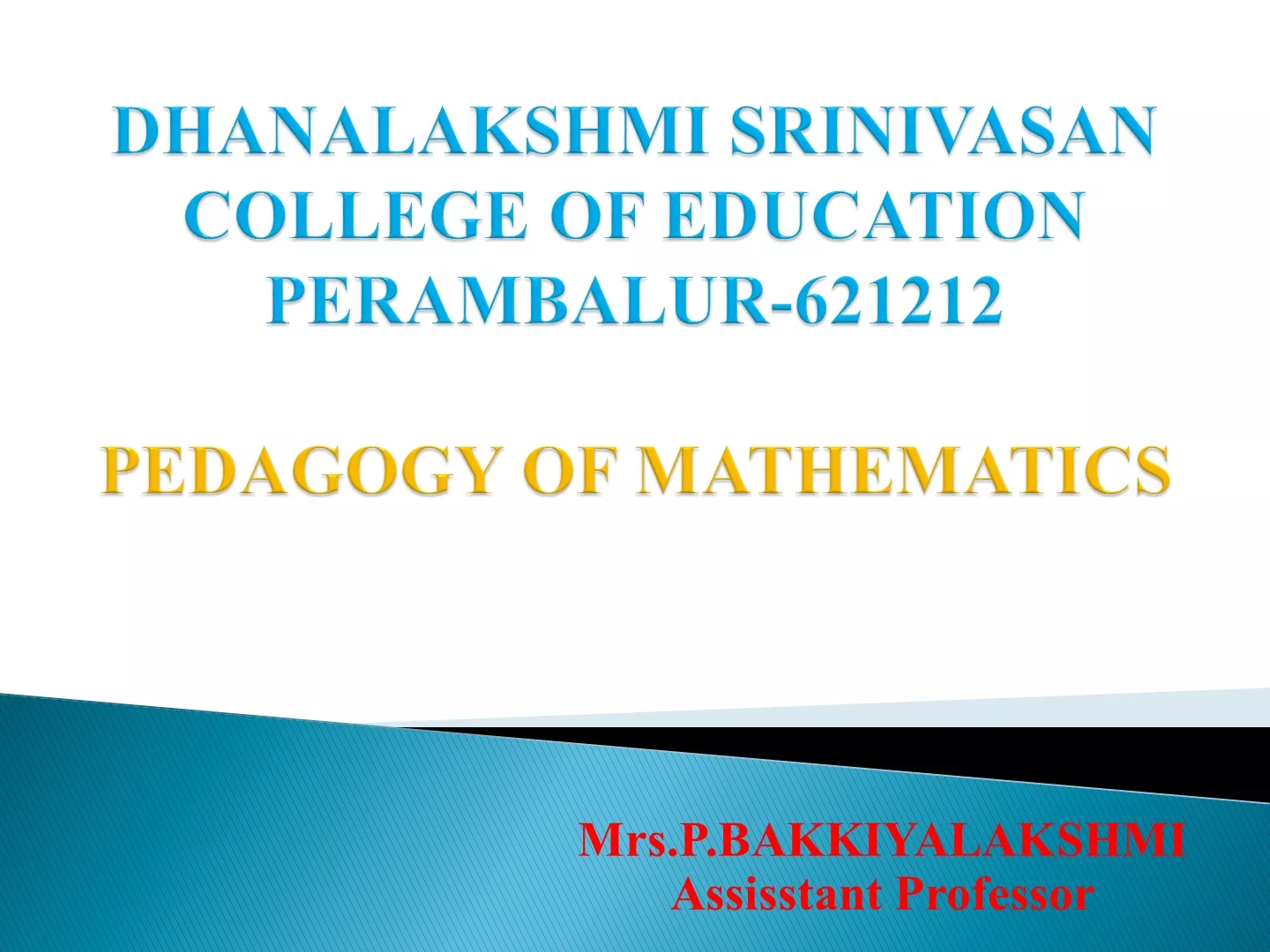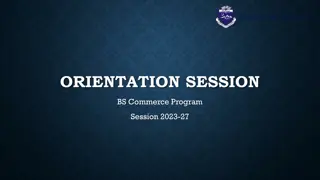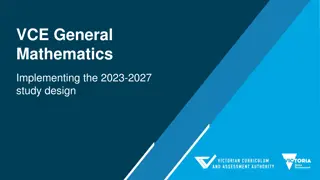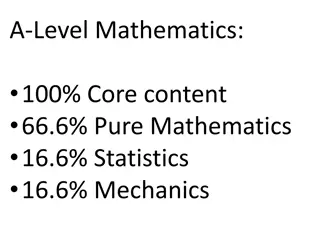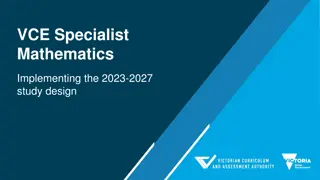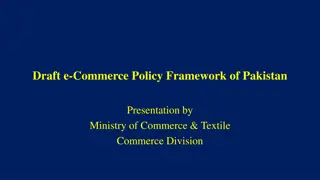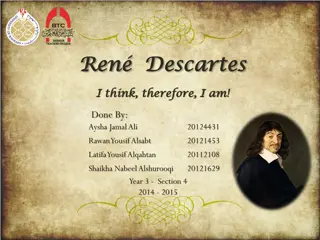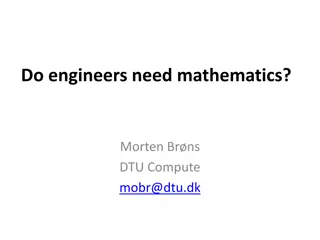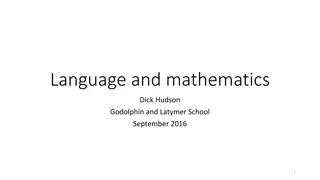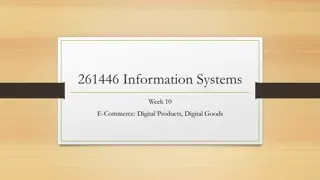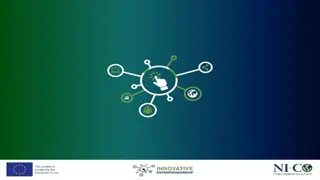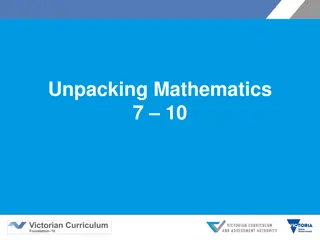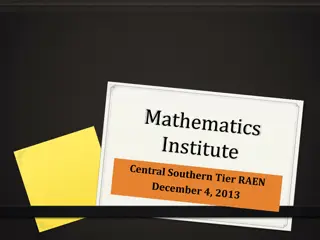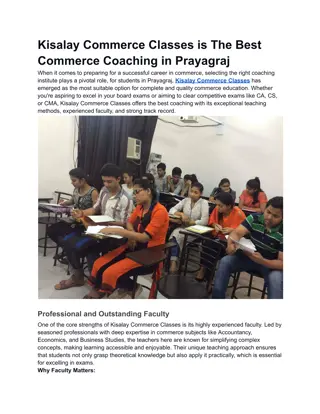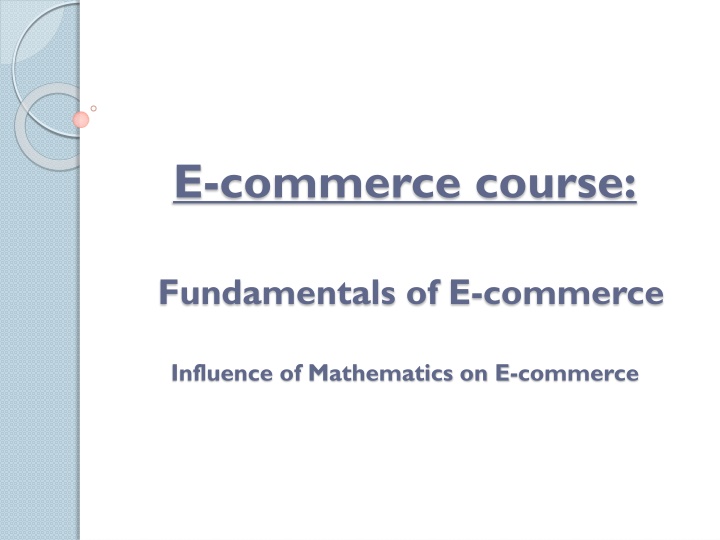
Mathematical Models in E-commerce: Enhancing Efficiency and Service Quality
Discover the significant role mathematics plays in e-commerce, with various models like probability theory and queuing theory optimizing processes. Explore how these mathematical concepts improve information flow, reduce waiting times, and enhance service quality in the digital marketplace.
Download Presentation

Please find below an Image/Link to download the presentation.
The content on the website is provided AS IS for your information and personal use only. It may not be sold, licensed, or shared on other websites without obtaining consent from the author. If you encounter any issues during the download, it is possible that the publisher has removed the file from their server.
You are allowed to download the files provided on this website for personal or commercial use, subject to the condition that they are used lawfully. All files are the property of their respective owners.
The content on the website is provided AS IS for your information and personal use only. It may not be sold, licensed, or shared on other websites without obtaining consent from the author.
E N D
Presentation Transcript
E-commerce course: Fundamentals of E-commerce Influence of Mathematics on E-commerce
Influence of Mathematics on E-commerce Many branches of mathematics and mathematical models are involved in e-commerce, the multidisciplinary science. Common mathematical models involved in e-commerce will briefly be introduced in relevant sections, such as probability model, queuing theory model, nonlinear dynamic model, graph theory model and many other equally important models such as Petri Net and commercial patterns.
1. Probability model: (1) Random event and probability In given condition, the thing that is likely to happen or not is called a Random event ( event , for short), usually represented by the capitalized letters such as A, B, C, etc. For instance, suppose tossing a coin in the homogeneous condition, heads occurring is a random event. In given condition, the thing that is sure to happen is called a certain event, represented by U. In given condition, the thing that is impossible to happen is called an impossible event, represented by I . (2) Probability model Probability theory is a science to study quantitative law of random phenomenon in nature. Random events in probability theory can be abstracted into three models: classical probability model, geometric probability model, and conditional probability model.
2. Queuing theory model: The information flow in e-commerce runs in global Internet. When the information arrives at the computer s intelligence node, it will flow to the next node, which needs processing by processors (called service in queuing theory). If information to be processed at the node is beyond the processing capacity of the processor, the information has to queue for processing. How long will the information has to wait for service? What is the length of the queue? How to arrange the queue to ensure the shortest queue, the lowest cost and the best service? All above problems will be studied in queuing theory. The model of queuing theory is shown in the following Figure.
That is, the information arrives at the service window according to some law, queues for service in terms of some laws and leaves after getting service. The following factors in queuing theory influence greatly on the whole process: F (laws of event arrival), S (service regulations), and M (numbers of service windows), by which we can express the mathematical models of queuing with the F/S/M in queuing theory.
If a model with poison's distribution as the event arrival, exponential distribution as the queuing discipline, first come, first served regulation as the service regulation, and the service windows being 5, its queuing model can be expressed by M/M/5. The queuing models in common use contain the M/M/S model (arrival and treatment are all exponential distribution, and the number of service windows is S), M/M/S (the arrival distribution is the exponential distribution, treatment distribution is random distribution, the number of service windows is S) and privileged M/M/S (Data are treated on a priority basis).
3. Nonlinear dynamic model Nonlinear science, a front-line science, is to study nonlinear phenomena in various subjects. It is a multidisciplinary science based on branches characterized by nonlinear, and is called the third revolution of natural science in the 20th century. The birth of nonlinear science reveals that people s cognition of things always goes from the easy to the difficult and complicated, and will gradually be deepened. Achievements of sciences make people enamored of the natural harmony and perfection, and form the idea that any complicated natural phenomenon can be described by a simple law or a set of specific mathematical equations.
It is almost agreed by all physical scientists that universal fundamental laws are decisive and reversible, among which Newton s Second Law, is the representative (m for particle mass, x for position vector of particle motion, F for external force). Actually it is not always the case, for there are the coexistences of both reversible and irreversible evolutionary processes, both determinacy phenomenon and chance phenomenon, both future incorporated in the past and future unincorporated in the past. Prigogine s Dissipative Structure theory questioned the symmetry of time, supplied new theory for the study of complicated phenomena in nature and therefore won the Nobel Prize in 1997.
Presently, dissipative structurology, chaos, bifurcation, mutation theory, fractal theory, synergetics, cellular automata complement with each other. Accordingly, the nonlinear dynamics, a multidisciplinary to study complicated phenomena, comes into being. Mathematical models studied in nonlinear dynamics contain dissipative structurological model, chaos model, bifurcation model, mutation theory model, fractal model, synergetics model, cellular automata model. It is difficult to describe chaos model, fractal mathematics model, synergetics model, and cellular automata model with specific mathematical equations. Much of nonlinear dynamics can be applied to e-commerce.
For instance, chaos and cellular automata have been used in e-commerce encryption, and fractal theory has been extensively applied in dada compression field, which meets the require- ment of high data compression ratio of (100:1)(1000:1). The mathematical formalisms of these models will not be listed here for they are so complicated that they cannot clearly be explained by general advanced mathematics. Readers who are interested in this can refer to pertinent literature. Various mathematical models shall be, without doubt, adopted to study Internet, an open and non linear system. For instance, cryptographic algorithm frequently used in e-commerce security is from the research of nonlinear dynamics.
4. Graph theory model Graph theory model is a powerful tool to depict discrete topology. There are always diagrams composed of node and edge in computer network study and computer program flow analysis. In the computer network constituted by these nodes and edges , the intelligent node are regarded as nodes and the closed path between node as edge . The knowledge of graph theory will be used in the selection of the routes etc. in information transmission. A graph G is comprised of vertex set V and edge set E. The following are models in graph theory.
(1) Directed Graph Model: The connectivity of vertex is with aeolotrophy, that is, the connectivity from vertex A to vertex B does not mean the connectivity from vertex B to vertex A. the following figure is an instance of Directed graph model.
(2) Undirected graph Model: The connectivity from vertex A to vertex B means the connectivity from vertex B to vertex A. The following figure is an instance of undirected graph.
(3) Complete Graph: Graph G is called a complete graph if there is always a edge to connect any two vertexs of the vertex set G. The Figure below is an instance of a complete graph.
(4) Connected Graph Model: If there is a path from vertex U to vertex V, U is accessible to V. If any two vertexes in graph G are all mutually accessible, the graph is called strongly connected. The Figure below is an instance of strongly connected graph.
(5) Euler Graph Model: In graph G, Eulers circuit refers to the circuit which passes each edge once and only once. In the Euler s circuit, a vertex can be repeatedly passed. This Figure is an instance of Euler graph.
(6) Hamilton Graph Model: In graph G, the circuit that passes every vertex once and only once, is called the Hamilton circuit; if there is the Hamilton circuit in G, G is called the Hamiltonian graph. This Figure is an instance of Hamilton graph.
(7) Matrix representation of graph: Though graph is intuitionistic, it is difficult to deal with by computers and brings inconvenience to the graph study. The representation of matrix, another representation of the graph, is introduced by scientists to overcome the shortcoming. Supposing the number of vertexes in graph G is m and the number of edges is n, the matrix of graph G, , mn u can be expressed by among which element can be determined by the follows: A, called the adjacency matrix, facilitates the analysis of a graph, by which the length of directed circuit, undirected circuit, unconnected circuit and connected circuit can expediently be researched.
Refrences [1] Qin Z., Li S D. An Compendium to E-Commerce. Beijing: Higher Education Press, 2001. [2] Qin Z., Xie G T., Li S D., & Jia X L. E-Commerce System Structure and System Design. Xi an: Xi an Jiaotong University Press, 2001. [3] Qin Z., Han Y. & Yan L X. Computer System Intergration and E-commerce. Xi an: Xi an Jiaotong University Press, 2001. [4] Qin Z., Wang Z M. & Bao F M. Design Practice of Virtual Network. Xi an: Xi an Jiaotong University Press, 2001. [5] Qin Z., Liu X Y. & Wang LR. Case Study on E-commerce. Xi an: Xi an Jiaotong University Press, 2001. [6] Qin Z., Wang Y L., Zhang L. & Wei M T. Virtual Business Management. Xi an: Xi an Jiaotong University Press, 2001. [7] K. Laudon, C. Traver. E-Commerce: Business, Technology, Society (3rd Edition). Prentice-Hall, Inc. NJ, USA. 2006. [8] William G.Page.Jr. A Handbook of Oracle 8/8i Development and Application (the first edition) Beijing: Machinery Industry Press, 2000. [9] Wang Q., Qiu R J. & Wang H W. The Design and Achievement of Client s Information Management System. Information Techniques, Issue 7, 2000, & Issue 87, 2000, 1820. [10] F. Damanpour. E- business E-commerce Evolution: Perspective and Strategy. Managerial Finance. Vol.27 (7): 16-33, 2001. [11] Yu Z T., Song L Z. Che W G. & Guo J Y. The Strategies of Database Techniques in Shopping Vehicles on Internet. Computer Application, No.8, Vol (20), 2000, 6668. [12] W. David. E-commerce: Strategy, Technologies And Applications. TATA MCGRA, India, 2000. [13] Zhang C X., Tang J G. & Xie Y F. The Establishment of Bamboo Product Information System Database and the Design of Information Inquiry Function. Journal of Najing Forestry University Sum No.70, Volume 12, 1996. [14] Daniel I. Joshi, Pavel A. A Complete Collection of References for Java Programmers. (the first edition) Beijing: China Water Conservancy and Hydroelectricity Press, 1999. [15] E. Turban, C. Cohen, I. M. Copi et al. Introduction to E-Commerce. Pearson Education, NJ, USA, 2003. [16] Yen-Liang Chang, Chen, S. Chyun-Chyi Chen Chen, I. Workflow process Definition and Their Applications in E-commerce. Multimedia Software Engineering, 2000. Proceedings. International Symposium on, 2000, 193200. [17] Weaver, A.C. Vetter, R.J. Whinston, A.B. Swigger, K. The future of E-commerce. Computer, Volume: 33 Issue: 10, Oct. 2000, 3031. [18] S. Korper, J. Ellis. The E-commerce Book: Building the E-empire. Morgan Kaufmann, San Fransisco, USA, 2001. [19] Bhaskaran, K. Jen-Yao Chung Das, R. Heath, T. Kumaran, S. Nandi, P. An E-business Integration & Collaboration Platform for b2b E-commerce. Advanced Issues of E-Commerce and Web-Based Information Systems, WECWIS 2001, Third International Workshop on, 2001, 120122. [20] A. Panagariya. E-Commerce, WTO and Developing Countries. World Economy, Vol.23 (8): 959978, 2002. [21] Pi Y. On Technological Crime in the Field of Finance. Legal Science Review, 2000. [22] Qu X W. Crime on Internet and Its Containing. Legal Science Study, 2000. [23] Wang Y. A Brief Analysis on E- commerce Law Issues. Legal Science Review, 2000. [24] Wi J P. E-commerce in China: Problems and Their Countermeasures. China Computer Paper, 1999. [25] Venkatraman, Mahadevan; Singh, Munindar P. Verifying Compliance with Commitment Protocols. Autonomous Agents and Multi-Agent Systems; 13872532; No.3 (2), 1999. [26] Shaw, Michael J. Electronic Commerce: Review of Critical Research Issues. Information Systems Frontiers; 13873326; No.1 (1), 1999. [27] Garrett, S. G. E.; Skevington, P. J. An Introduction to Electronic Commerce. BT Technology Journal; 13583948 No.3 (17), 1999. [28] Unitt, M., Jones, I. C. EDI-The Grand Daddy of Electronic Commerce. BT Technology Journal; 13583948; No.3 (17), 1999. [29] Trask, N. T. Meyerstein, M. V. Smart Cards in Electronic Commerce. BT Technology Journal; 13583948; No.3 (17), 1999. [30] S. S. Y. Shim, V. S. Pendyala, M. Sundaram, J. Z. Gao, Business-to-Business E-Commerce Frameworks. Computer, vol. 33(10): 4047, 2000. [31] D. Kinyon. Quarterly retail e-commerce sales: 4th quarter 2007. US Census Bureau News 2008, CB08-24. [32] A. K. Ghosh, T. M. Swaminatha. Software security and privacy risks in mobile e-commerce. Communications of the ACM, Vol. 44(2): 5157, 2001. [33] S. Hawk. A Comparison of B2C E-Commerce in Developing Countries. Electronic Commerce Research, Vol. 4(3): 181199, 2004. [34] Lu X D. Making and Implementing E-commerce Strategies with Chinese Characteristics. Dongyue Series, 2001(01): 6063. [35] Liu J. Key Points and Measures of E-commerce Strategies in Canana. Global Watch of Science and Technology and Economy, 2000(6): 1415. [36] Tian H. Japan Plans to Be the Most Advanced Country in IT within Five Years. East Web. [37] He D G. Catching up with and Surpassing America: the Dream of Japanese IT Revolution. Army Paper, May 16th, 2002. [38] Japan Publicizes New IT Strategies of the Year 2002. People s Daily, June 28th. 2001. [39] A. Tsalgatidou, J. Veijalainen. Requirements for Mobile E- Commerce in E-Business:Key Issues, Applications, Technology, In: Proceedings of the E-business and E-work Conference, Madrid, Spain, 18-20 October 2000.

